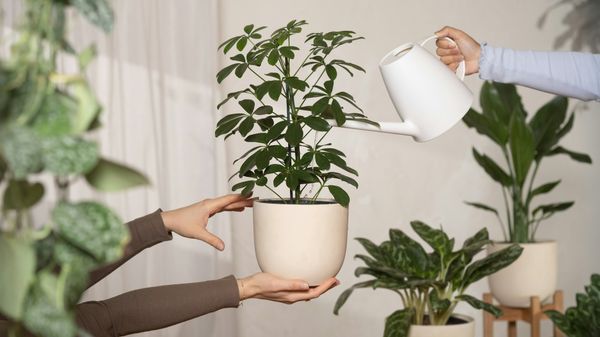Umbrella Plant Care Guide
How to grow and care for Umbrella Plant (Schefflera arboricola)
The Schefflera arboricola, commonly known as the Umbrella Plant, is a popular indoor plant cherished for its lush foliage and ease of care. This versatile tropical plant is native to Taiwan and features glossy, palmate leaves that resemble the spokes of an umbrella, hence its common name. Schefflera arboricola not only adds a touch of nature to indoor spaces but also acts as a natural air purifier, making it a favorite among houseplant enthusiasts.

Disclosure: This content includes affiliate links, which means we may earn a commission if you click on a link and make a purchase. As an Amazon Associate, we earn from qualifying purchases. This comes at no extra cost to you and helps offset the cost of running Leafwise. Please read our disclaimer for more info.
Table of Contents
Care
Light
The Umbrella Plant thrives best in bright, indirect sunlight. Although it can adapt to lower light conditions, insufficient light can result in leggy and sparse growth. For optimal health and a compact appearance, ensure your plant receives consistent indirect light.
Watering
Water thoroughly once the top inch of soil feels dry. Allow excess water to drain fully, and let the soil dry out between waterings to prevent root rot and fungal issues.
Humidity & Temperature
Umbrella Plants prefer humidity levels around 60% but can tolerate average indoor conditions. If your indoor environment is dry, increase humidity using a humidifier, pebble tray, or frequent misting. Ideal temperature ranges are between 65-75°F (18-24°C).
Soil
Use a well-draining soil mixture, such as standard potting mix enhanced with perlite or orchid bark. Adding organic materials like compost or coco coir can improve soil fertility and drainage, benefiting overall plant growth.
Fertilization
Feed monthly during the active growing season (spring and summer) using a balanced liquid fertilizer diluted to half strength. Monitor your plant and adjust fertilization frequency according to its response.
Maintenance
Pruning
Regular pruning maintains a desirable shape, removes damaged foliage, and promotes fuller growth. Shortening the shoot tips encourages bushiness and helps your plant stay compact and lush.
Cleaning
Periodically clean leaves with a damp cloth to remove dust and promote a healthy, glossy appearance, enhancing the plant's photosynthesis and overall vigor.
Repotting
Repot every 2-3 years or when the plant becomes root-bound, ideally during early spring. Choose a pot slightly larger than the current container, ensuring it has adequate drainage holes to prevent waterlogging.
Propagation
The best time for propagation is late spring or early summer. Select a healthy stem cutting of about 4-6 inches with several leaves. Remove lower leaves and optionally apply rooting hormone to encourage quicker root development.
Place the cutting either in water or directly into a moist, well-draining potting mix. Position it in bright, indirect light, maintaining consistent moisture levels. Once the roots reach approximately 2-3 inches, transplant the cutting into a small pot with fresh soil. Continue to keep the soil consistently moist and provide indirect light until the plant establishes itself and new growth emerges. Gradually transition to regular care routines afterward.
Common Issues
Pests
Cause: Common pests include spider mites, aphids, and mealybugs, often exacerbated by low humidity and poor plant hygiene.
- Solution: Regular inspections and maintaining proper humidity are key. Use insecticidal soap or neem oil at first signs of infestation.
Root Rot
Cause: Typically results from overwatering and inadequate drainage.
- Solution: Improve drainage, use pots with appropriate drainage holes, adjust watering habits, and allow the soil to dry slightly between waterings.
Yellowing Leaves
Cause: Often caused by overwatering, low humidity, or insufficient lighting.
- Solution: Reassess watering practices, enhance indirect light exposure, and ensure proper humidity levels.
Leaf Drop
Cause: Frequently occurs due to sudden temperature fluctuations, repotting stress, improper watering, or exposure to drafts.
- Solution: Maintain stable environmental conditions, consistent care routines, and shield the plant from drafts and rapid temperature changes.
